10 Best Direct Carbon/Air Capture Offsets (Complete 2025 List)
Affiliate Disclosure
Hey fellow impactful ninja ?
You may have noticed that Impactful Ninja is all about providing helpful information to make a positive impact on the world and society. And that we love to link back to where we found all the information for each of our posts.
Most of these links are informational-based for you to check out their primary sources with one click.
But some of these links are so-called "affiliate links" to products that we recommend.
Why do we add these product links?
First and foremost, because we believe that they add value to you. For example, when we wrote a post about the environmental impact of long showers, we came across an EPA recommendation to use WaterSense showerheads. So we linked to where you can find them. Or, for many of our posts, we also link to our favorite books on that topic so that you can get a much more holistic overview than one single blog post could provide.
And when there is an affiliate program for these products, we sign up for it. For example, as Amazon Associates, we earn from qualifying purchases.
What do these affiliate links mean for you?
First, and most importantly, we still only recommend products that we believe add value for you.
When you buy something through one of our affiliate links, we may earn a small commission - but at no additional costs to you.
And when you buy something through a link that is not an affiliate link, we won’t receive any commission but we’ll still be happy to have helped you.
What do these affiliate links mean for us?
When we find products that we believe add value to you and the seller has an affiliate program, we sign up for it.
When you buy something through one of our affiliate links, we may earn a small commission (at no extra costs to you).
And at this point in time, all money is reinvested in sharing the most helpful content with you. This includes all operating costs for running this site and the content creation itself.
What does this mean for me personally?
You may have noticed by the way Impactful Ninja is operated that money is not the driving factor behind it. It is a passion project of mine and I love to share helpful information with you to make a positive impact on the world and society. However, it's a project in that I invest a lot of time and also quite some money.
Eventually, my dream is to one day turn this passion project into my full-time job and provide even more helpful information. But that's still a long time to go.
Stay impactful,
Direct carbon/air capture (DCC) is one of the most effective ways of reducing global atmospheric carbon dioxide (CO2) levels and locking CO2 away for thousands of years. Partnered with carbon offsets, DCC could play a crucial role in mitigating climate change. So, we had to ask: what are the best direct carbon capture offsets?
The best direct carbon/air capture offsets are offered by Climeworks, Novocarbo, and Heirloom that all capture CO2 from the air and store it permanently. In addition, Captura capture and store CO2 with the help of ocean water and Carbin Minerals via the natural process of weathering and mineralization.
Keep reading to learn more about the best direct carbon capture offsets, how these carbon offset projects work and what their respective offsetting costs are. At the end of the article, we’ll also share with you how effective direct carbon capture offsets are, what their pros and cons are, and how these offsets can help mitigate climate change.
Here’s What All the Best Direct Carbon/Air Capture Offsets Have in Common
Carbon offsets are reductions in carbon emissions that are used to compensate for carbon emissions occurring elsewhere. They are measured in tons of CO2 equivalents and are bought and sold through international brokers, online retailers, and trading platforms on what is known as the global carbon offset market.
“Carbon offset: a way for a company or person to reduce the level of carbon dioxide for which they are responsible by paying money to a company that works to reduce the total amount produced in the world, for example by planting trees”
Oxford Dictionary
Direct carbon/air capture (DCC) offsets are a technology-based carbon offset solution, where plants are constructed that suck CO2 out of the air and store it in underground geological formations. CO2 reduction occurs immediately, making DCC an effective way to reduce CO2 emissions.
“Direct carbon capture: the process of storing carbon dioxide that has been collected and removed from the atmosphere, in solid or liquid form”
Oxford Dictionary
The two main types of DCC are liquid and solid DCC:
- In liquid systems, air is passed through chemical solutions to remove the CO2.
- In solid systems, sorbent filters are heated and placed under a vacuum to release CO2, which is then captured for storage or use.
These Are the Best Direct Carbon/Air Capture Offsets in 2025
Below are our favorite direct carbon capture offsets (you can click on their link to directly jump to their section in this article):
| Direct Carbon/Air Capture Offsets | Quick Facts |
| Climeworks | About: Carbon offset purchases support the practice of direct CO2 removal, where specialized machines remove CO2 directly from the air and store it in rock formations underground. Costs: $1,200 per 1,000kg of CO2 |
| Novocarbo | About: Novocarbo uses pyrogenic carbon capture and storage, which converts CO2 into regenerative energy and biochar. The biochar can be used as soil, as a replacement for cement, and in regenerative agriculture. Costs: Novocarbo uses resellers (e.g., Puro.earth and Carbonfuture), costs are determined with these. |
| Heirloom | About: Heirloom’s technology captures CO2 through an accelerated process of natural mineralization, whereby minerals absorb CO2 from the air. The CO2 is then injected underground and stored permanently. Costs: Costs are determined after initial contact. |
| Captura | About: Captura’s systems remove CO2 from the atmosphere with renewable electricity and ocean water. The captured CO2 is then either sequestered or re-purposed. Costs: Estimated at less than $100 per ton of CO2. |
| Carbin Minerals | About: Carbin Minerals speeds up the natural process of weathering, where rocks absorb CO2 from the atmosphere and turn it into a mineral. They partner with mines and transform mine tailings into giant carbon sinks capable of extracting and permanently storing large amounts of CO2. Costs: Costs are determined after initial contact. |
| Neustark | About: Neustark removes CO2 from the atmosphere and stores it in recycled concrete, and they cut new CO2 emissions by reducing the use of traditional cement. Costs: Costs are determined after initial contact. |
| Parallel Carbon | About: Parallel Carbon uses mineral looping to separate CO2 from the ambient air. The captured CO2 can be repurposed or injected underground and permanently stored. Costs: Costs are determined after initial contact. |
| Carbo Culture | About: Carbo Culture converts CO₂ from plants into biochar and stores it permanently underground. Costs: Costs are determined after initial contact. |
| Carbonbuilt | About: Carbonbuilt takes CO2 generated by industrial processes and transforms it into precast concrete. Costs: One-time or monthly subscription options for $200 per ton of CO2 + processing fees. |
| Noya | About: Noya specializes in direct air capture via retrofitted cooling towers that suck CO2 from the air. They then either sequester, sell, or repurpose the captured CO2. Costs: Carbon credits are free of charge, costs are associated with retrofitting your cooling tower. |
Climeworks: The Leader in Direct CO2 Removal
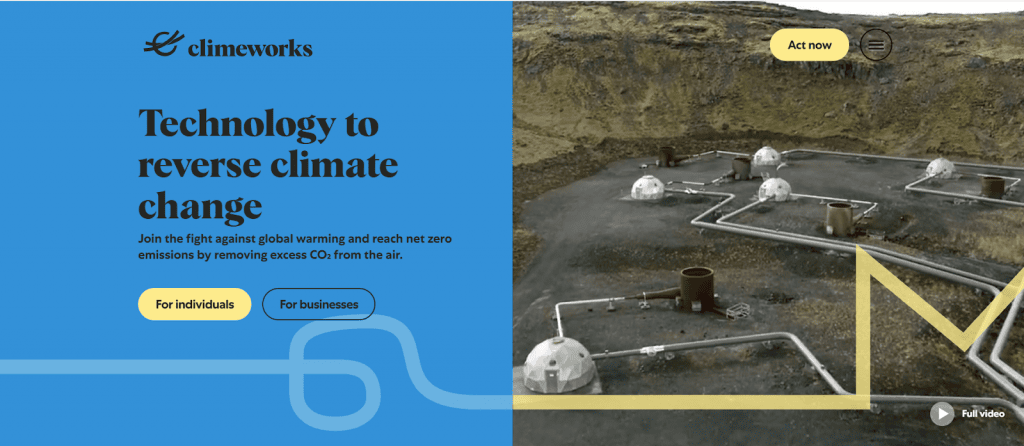
Climeworks, a DAC company in Zurich, Switzerland, is the leader in the CO2 removal game. It was founded in 2009 by engineering university students Jan and Christoph, who were shocked at the melting glaciers in the Swiss Alps. Climeworks’ mission is to inspire one billion people to remove CO2 from the air and reverse climate change.
“Let’s reverse climate change”
Climeworks
Project overview: The Climeworks specialized machines take CO2 from the air, mix it with water, and pump it deep underground. Through the process of natural mineralization, the captured CO2 is turned to stone. Since their inception in 2017, Climeworks has built 15 DAC machines. In 2021, they switched on the world’s first large-scale DCC plant, called Orca. And in the same year they also began construction for their newest DCC plant, Mammoth, which will have an annual carbon capture capacity of 36,000 tons, nine times that of the Orca plant. The current efficiency rate of their DCC plants of capturing CO2 lies at over 90% permanent removal, with only up to 10% of emissions being re-emitted by operating their machines.
Carbon offset effectiveness: Climeworks offsets are permanent, measurable, and effective.
Carbon offset costs: Climeworks offers monthly, one-off, or gift carbon purchase options at a cost of $1.20 per 1kg of CO2 removed.
How to get your carbon offsets: You can get your carbon offsets directly from Climework’s webshop, where you can also select how much CO2 you want to remove along with your preferred frequency (monthly, one-off, or gift).
Novocarbo: Repurposing CO2 Into Sustainable Products

Novocarbo has been capturing CO2 in biochar since 2018, and today they offer one of the first scalable carbon removal solutions on the European market. Their mission is to remove CO2 from the atmosphere now, because our climate can’t wait.
“Because we can scale anywhere”
Novocarbo
Project overview: Novocarbo uses pyrogenic carbon capture and storage (PyCCS), which converts CO2 into regenerative energy and biochar, thereby locking away the carbon for thousands of years. The biochar can be used as soil, as a replacement for cement, and in regenerative agriculture. Through this process, Novocarbo generates carbon credits which they sell through the Puro.earth and Carbonfuture trading platforms.
Carbon offset effectiveness: Novocarbo’s process complies with the European Biochar Consortium (EBC) standard. To be listed on Puro.earth, Novocarbon also had to undergo third-party independent verifiers who audit carbon removal project facilities and issue CORCs; and to be listed on Carbonfuture, Novocarbo have to comply with their high standards, including third-party methodology, certification, and auditing.
Carbon offset costs: Novocarbo uses resellers to sell their carbon capture solutions.
Visit the Puro.earth, or Carbonfuture website to learn more about their respective pricing.
How to get your carbon offsets: You can get your Novocarbo offsets through the Puro.earth, or Carbonfuture websites.
Heirloom: A Carbon Mineralization Solution

Heirloom was founded on the belief that everyone on this planet deserves to thrive, and climate equity plays a big role in making that happen. They are striving to create a resilient, equitable, and prosperous world for everyone. Their mission is to remove one billion tons of CO2 from the air by 2035 by engineering the most cost-effective, scalable direct air capture system.
“Restoring balance to our atmosphere”
Heirloom
Project overview: Heirloom’s carbon removal technology speeds up the process of natural mineralization, whereby minerals absorb CO2 from the air. The CO2 is then injected underground and stored permanently.
Carbon offset effectiveness: Heirloom’s process permanently locks away CO2 in underground geological formations. The process is permanent, sustainable, and compact.
Carbon offset costs: Costs are determined after initial contact with the Heirloom team.
How to get your carbon offsets: You can get in touch with a representative to get your carbon offsets.
Captura: Capturing CO2 from Ocean Water at Scale
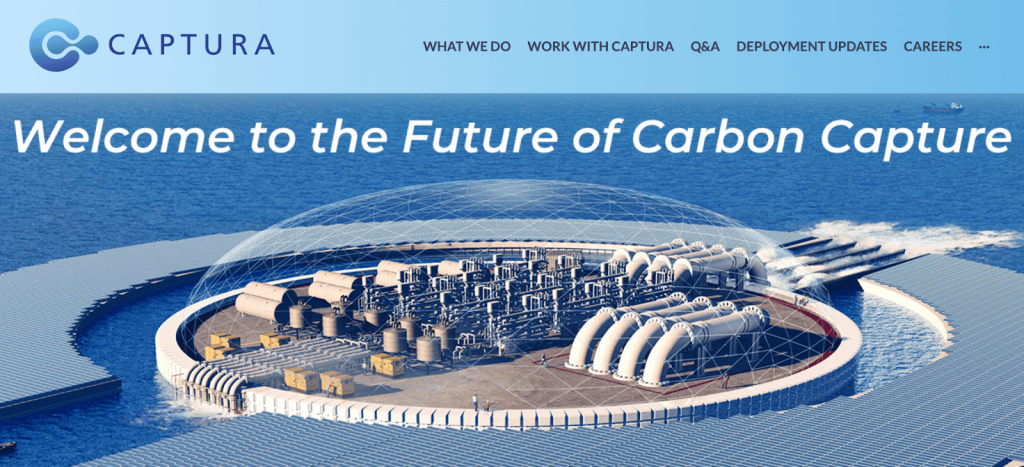
Captura was founded in 2021 as a provider of low-cost, atmospheric carbon removal via the use of our largest natural CO2 absorber, our oceans. Their mission is to provide a globally scalable tool for climate action.
“Captura offers a critical tool in the fight against climate change utilizing unique gigaton-scalable Direct Ocean Capture (DOC) technology developed at Caltech.”
Captura
Project overview: In general, Captura’s systems use renewable electricity and ocean water to remove CO2 from the atmosphere. Captura’s technology purifies ocean water into salt water, which undergoes electrodialysis to create an acid and a base, the former of which draws out CO2. The CO2 is captured and subsequently sequestered or re-purposed. This process produces high-quality carbon credits, which they can supply directly or through their licensing partners.
Carbon offset effectiveness: Captura’s carbon offsets are permanent, verifiable, additional, and have minimal land-use impacts.
Carbon offset costs: Captura estimates that their carbon credits cost below $100 per ton of CO2 .
How to get your carbon offsets: You can visit their website and contact a representative to learn more and to get your carbon offsets.
Carbin Minerals: Reimagining Mine Waste
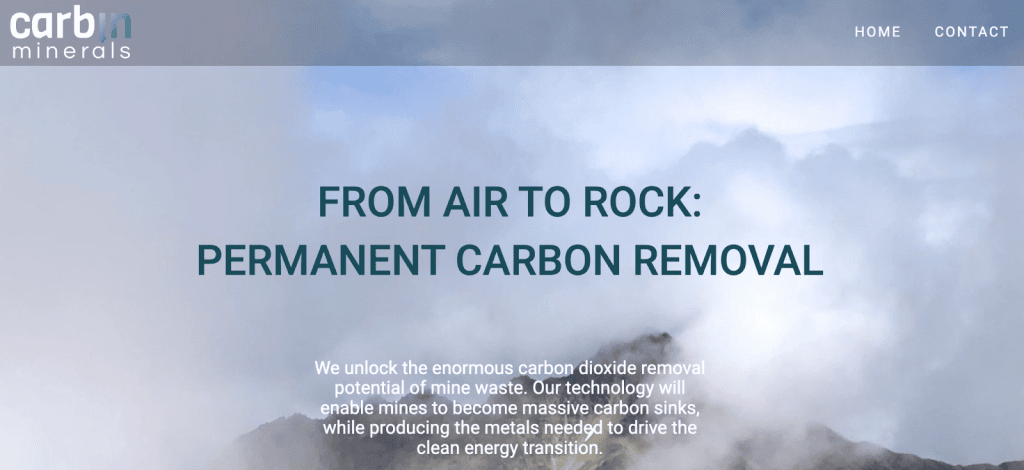
Carbin Minerals was founded in 2021 and is based in Vancouver, Canada. Through the natural process of weathering and using mine tailings, they aim to reduce the amount of CO2 in the atmosphere and turn the dial on climate change. Their mission is to provide durable carbon removal on a gigaton scale.
“From Air to Rock – Permanent Carbon Removal”
Carbin Minerals
Project overview: Carbin Minerals utilizes the natural process of weathering, where rocks absorb CO2 from the atmosphere and turn it into a mineral. But instead of the process taking thousands of years, Carbin Minerals has developed research that speeds up the process into a matter of weeks or days. And by partnering with mines, they can transform mine tailings into giant carbon sinks capable of extracting and permanently storing large amounts of CO2.
Carbon offset effectiveness: Carbin Minerals provides carbon offsets that are permanent and verifiable.
Carbon offset costs: Costs are determined after initial contact with the Carbin Minerals team.
How to get your carbon offsets: Contact a team representative to get your carbon offsets.
Neustark: Storing CO2 in Concrete
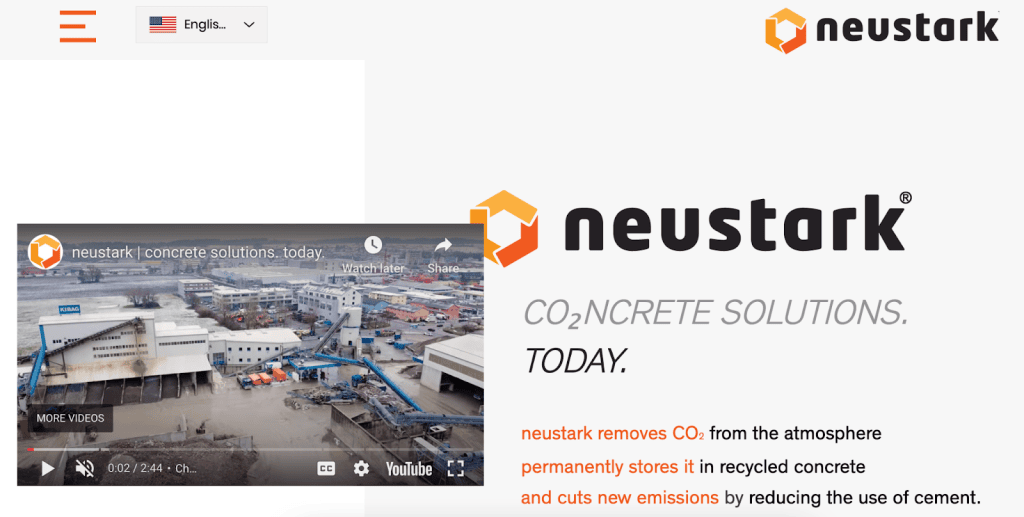
Neustark was founded in 2019 on the shared vision of a solution for the utilization and storage of CO2. Today they have developed technology that produces one of the most climate-friendly concrete. Their mission is to reduce the global construction industry’s carbon footprint by 1 billion tons of CO2 per year by 2050.
“Co₂ncrete Solutions. Today.”
Neustark
Project overview: Neustark removes CO2 from the atmosphere and permanently stores it in recycled concrete via the process of mineralization, what they call their ‘Carbon Dioxide Removal (CDR) service’. Approximately 10kg of CO2 are stored per cubic meter of concrete, and up to 20kg of CO2 emissions are avoided in the concrete production process. This results in a carbon removal efficiency of 95%.
Carbon offset effectiveness: Neustark’s carbon credits are permanent, safe, and only issued for a net carbon removal. Their process is also credited by the Gold Standard.
Carbon offset costs: Costs are determined after initial contact with the Neustark team.
How to get your carbon offsets: You can directly contact a representative to get your carbon offsets.
CarbonBuilt: Converting CO2 to Concrete

CarbonBuilt is a company working to create a world where global economic prosperity no longer threatens our climate. Through their patented process, they transform CO2 into precast concrete. Their mission is to help concrete manufacturing drive greenhouse gas emissions reduction by using CO2 and other industrial wastes in a cost effective manner.
“Carbon for good™”
CarbonBuilt
Project overview: CarbonBuilt takes CO2 generated by industrial processes and transforms it into precast concrete, where it remains locked away for 1,000+ years. The result is a 70 to 100+% reduction in the concrete’s carbon footprint. Their carbon credits are generated by removing cement and switching to materials produced with a lower carbon footprint (carbon avoidance) and by using natural mineralization to capture CO2 from industrial processes (carbon removal).
Carbon offset effectiveness: CarbonBuilt’s projects are measurable, permanent, and additional.
Carbon offset costs: Carbonbuilt offers a one-time or monthly subscription option for $200 per ton of CO2 removal + processing fees.
How to get your carbon offsets: You can visit their website to directly purchase your carbon offsets.
Parallel Carbon: Carbon Removal in Parallel with Decarbonization
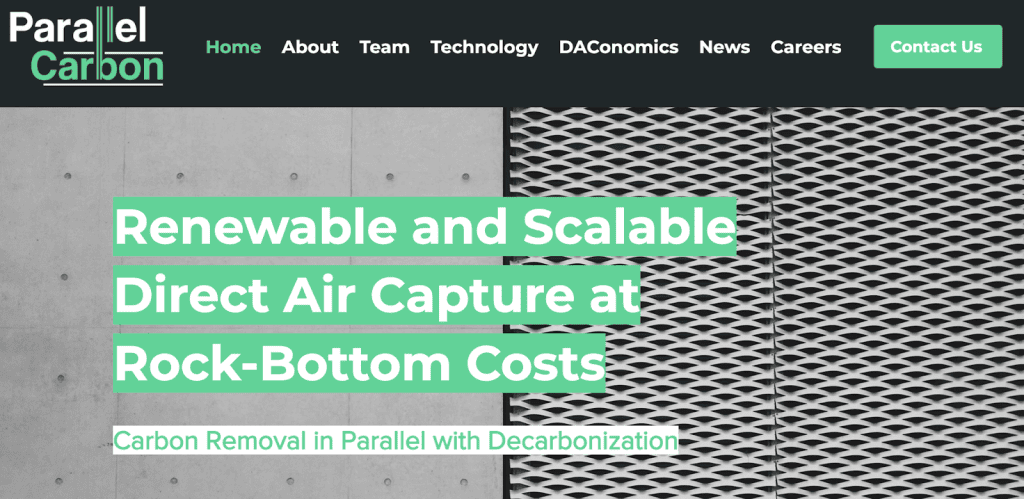
Parallel Carbon was founded during the COVID-19 pandemic as a company focused on developing technology that is compatible with renewable energy, reduces fossil fuel demands, and reduces the cost to achieve net zero. Their mission is to remove and sequester more than 2 gigatons of CO2 per year from the air by 2040.
“Renewable and scalable direct air capture at rock-bottom costs”
Parallel Carbon
Project overview: Parallel Carbon uses a patent-pending direct air capture technology that is based on the process of mineral looping. This process is based on wind, sun, and minerals. Renewable energy powers electrolytic operations to create acids and bases which are then used to separate CO2 from the ambient air. The captured CO2 can be repurposed or injected underground and permanently stored. The process itself generates high-quality carbon credits that can be sold.
Carbon offset effectiveness: Parallel Carbon’s carbon credits are scalable, based on renewable energy, and are permanent (with a 100-1,000 year permanence when stored in carbonate rocks or when sequestered underground in wells).
Carbon offset costs: Costs are determined after initial contact with the Parallel Carbon team.
How to get your carbon offsets: Contact a Parallel Carbon representative to get your carbon offsets.
Carbo Culture: Nature + Engineering to Lock Away Carbon

Carbo Culture has been in the works since 2013, when its founders first developed a novel carbon removal solution. Today, Carbo Culture is a team of engineers, climate experts and change makers on a mission to draw down 1 billion tons of CO2 from the atmosphere.
“Technology to permanently keep CO2 out of the air”
Carbo Culture
Project overview: In the natural carbon cycle, living plants draw down carbon from the atmosphere, and decomposing plants release carbon back into the atmosphere. Carbo Culture’s patented technology, Carbolysis™, hacks this cycle and converts the CO₂ from decomposing plants into biochar, preventing it from being re-emitted into the atmosphere. It can then be stored permanently underground. Carbolysis™ converts agricultural waste into biochar, generates usable heat, and produces carbon credits.
Carbon offset effectiveness: Carbo Culture’s offsets are permanent, as biochar is stored underground and will not decompose for over 1,000 years.
Carbon offset costs: Costs are determined after initial contact with the Carbo Culture team.
How to get your carbon offsets: You can contact a representative to get your carbon offsets.
Noya: Capturing CO2 With Cooling Towers
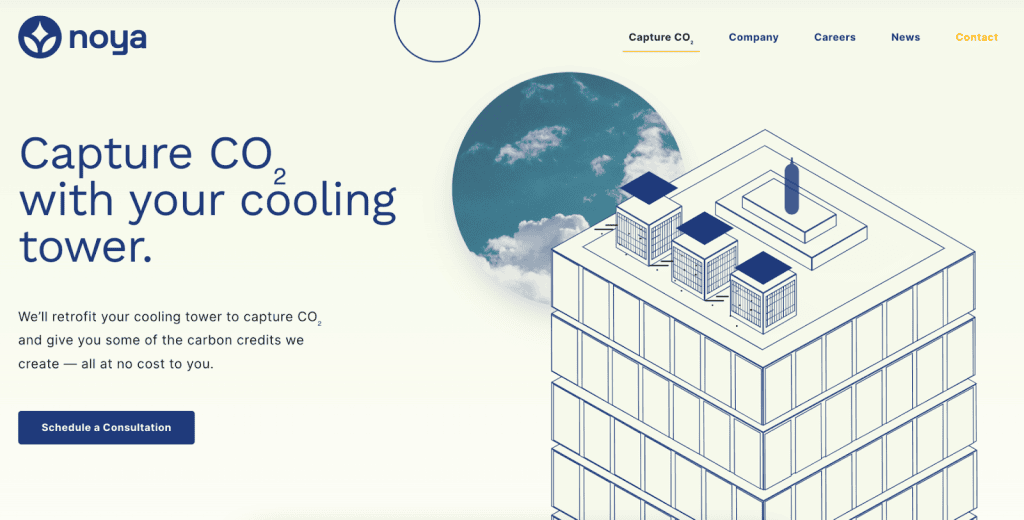
Noya is a US-based company founded in 2020 that specializes in direct air capture via retrofitted cooling towers that suck CO2 from the air. Their mission is to retrofit all of the 2 million cooling towers in the US to mitigate climate change.
“Accelerating the world towards carbon neutrality.”
Noya
Project overview: Noya is working to retrofit cooling towers in the US to perform direct air capture. They do so by installing ducting and CO2 capture equipment alongside your cooling tower and CO2 processing equipment downstream from it. They then add a chemical blend to the water that binds CO2 so it can be captured and removed. And they share with you the carbon credits that are generated.
Carbon offset effectiveness: Noya carbon credits are permanent, as their technology captures and removes CO2 from the air.
Carbon offset costs: Carbon credits generated from the retrofitted cooling towers are provided to you at no cost. Contact a representative to discuss the costs involved with retrofitting your cooling tower.
How to get your carbon offsets: You can schedule a consultation with a representative to purchase your carbon offsets.
How Effective and Efficient Are Direct Carbon/Air Capture Offsets
In terms of efficiency, direct carbon capture (DCC) offsets have a low rate of carbon re-emission, a low land-usage requirement, and a low life-cycle carbon footprint.
In terms of effectiveness, DCC offsets are effective at mitigating climate change because they are permanent and immediate, but they do not reduce your own carbon emissions.
DCC offset projects are efficient at reducing CO2 emissions because they:
- Can have a low rate of carbon re-emission when the plant is operated by low-carbon electricity
- Can have low land-usage requirements depending on the type of plant and the energy source that powers it
- Have a low life-cycle carbon footprint across their building, operating, and building back stages
DCC offsets are effective at mitigating climate change because they:
- Permanently remove carbon from the atmosphere
- Remove CO2 emissions immediately upon operation of the DCC machines
However, DCC offsets do not reduce your own carbon emissions, which can lead to greenwashing. This occurs when emissions are only offset and not reduced from the source, and the consumer is deceived into thinking they are offsetting their emissions but in reality they are not. This is why we should first reduce our emissions before relying on offsets.
What Are The Pros and Cons of Direct Carbon/Air Capture Offsets
Direct carbon capture (DCC) offsets are permanent, immediate, improve air quality and protect ecosystems, have low rates of carbon re-emission, have low land-usage requirements, and have a low carbon footprint across their life cycle stages. They also allow us to reduce carbon emissions in ways we wouldn’t be able to accomplish individually.
However, DCC offsets are also expensive, are not yet scaled to compensate for all of our global carbon emissions, and do not reduce your own carbon emissions.
What Are the 7 Pros of Direct Carbon/Air Capture Offsets
DCC offsets have various pros that make them an effective, long-term solution to reducing global atmospheric CO2 levels.
| 7 Pros of Direct Carbon/Air Capture Offsets | Quick Facts |
| #1: DCC offsets permanently remove carbon from the atmosphere | Direct carbon capture (DCC) offsets are a specific type of carbon offset that remove carbon from the atmosphere and store it permanently in geological reservoirs. |
| #2: DCC plants have a low rate of carbon re-emission when the plant is operated by low-carbon electricity, making them effective at removing carbon | DCC facilities require energy to operate, they can re-emit only small amounts of CO2 if powered by low-carbon energy sources (i.e., solar or wind power). |
| #3: DCC removes CO2 emissions immediately upon operation of the DCC machines | CO2 emissions reductions from direct carbon capture (DCC) offsets occur as soon as the machines become operational. Once the machines start sucking in atmospheric air, CO2 removal begins. |
| #4: DCC plants can have low land-usage requirements depending on the type of plant and the energy source that powers it | The land usage requirement for direct carbon capture (DCC) offsets is relatively low, averaging between 0.4 and 66km2 needed to capture 1 million tons of CO2. |
| #5: DCC offsets have a low life-cycle carbon footprint | Building: If the DCC plant takes energy from the traditional power grid, then the land requirement would be little to none and the carbon footprint would be lower. Operating: Using low-carbon energy sources can help keep the carbon footprint of this phase very low, and DCC plants can have an average carbon re-emission rate as low as 10%. Building Back: DCC power plants have an estimated average life expectancy of 20 years if properly maintained. CO2 emissions here would occur when utilizing construction equipment to decommission the plant and perform land restoration. |
| #6: DCC offsets improve air quality and protects ecosystems | Removing carbon emissions from the atmosphere via DCC would lead to improved public health in terms of asthma, respiratory allergies, airway diseases, and lung cancer. Removing carbon from the atmosphere via DCC also promotes healthy ecosystems, which have been linked with cleaner air, water, and food. |
| #7: DCC offsets allow us to reduce carbon emissions in ways we wouldn’t be able to accomplish individually | We already have governmental-level policies in place to reduce carbon emissions, but DCC carbon offsets allow us to reduce emissions from activities where sustainable alternatives are not yet widely available. |
What Are the 3 Cons of Direct Carbon/Air Capture Offsets
Understanding the drawbacks of DCC offsets is important when implementing the technology on a large scale in order to mitigate climate change.
| 3 Cons of Direct Carbon/Air Capture Offsets | Quick Facts |
| #1: DCC offsets are the most expensive method of carbon removal | Direct carbon capture (DCC) offsets currency range anywhere from $250-$650 per ton, the highest out of all carbon removal methods. This cost varies depending on the type of technology. |
| #2: DCC offsets are not yet at a scale where they can compensate for our global carbon emissions | Currently, direct carbon capture (DCC) offsets are also not scaled enough to keep pace with our global carbon emissions. Because there are relatively few companies engaged in DCC practices, the amount of carbon they can remove is also limited. |
| #3: DCC offsets do not reduce you own carbon emissions, which can lead to greenwashing | If emissions are only offset and not reduced from the source, this could lead to greenwashing, when the consumer is deceived into thinking they are offsetting their emissions but in reality they are not. |
How Can Direct Carbon/Air Capture Offsets Help Mitigate Climate Change
Climate change is a severe and long-term consequence of fossil fuel combustion. DCC offsets can help mitigate climate change because they eliminate fossil-fuel derived carbon from our atmosphere which, if left untreated, can remain there for tens of thousands of years and exacerbate the negative effects of climate change.
How is Climate Change Defined
Climate change is arguably the most severe, long-term global impact of fossil fuel combustion. Every year, approximately 33 bt of CO2 are emitted from burning fossil fuels. The carbon found in fossil fuels reacts with oxygen in the air to produce CO2.
“Climate change: changes in the earth’s weather, including changes in temperature, wind patterns and rainfall, especially the increase in the temperature of the earth’s atmosphere that is caused by the increase of particular gasses, especially carbon dioxide.”
Oxford Dictionary
Atmospheric CO2 fuels climate change, which results in global warming. When CO2 and other air pollutants absorb sunlight and solar radiation in the atmosphere, it traps the heat and acts as an insulator for the planet. Since the Industrial Revolution, Earth’s temperature has risen a little more than 1 degree Celsius (C), or 2 degrees Fahrenheit (F). Between 1880-1980 the global temperature rose by 0.07C every 10 years. This rate has more than doubled since 1981, with a current global annual temperature rise of 0.18C, or 0.32F, for every 10 years.
As outlined in the 2015 Paris Climate Agreement, we must cut current GHG emissions by 50% by 2030 and reach net zero by 2050.
How Do Carbon Offsets Generally Help Mitigate Climate Change
Levels of carbon in our atmosphere that cause climate change have increased as a result of human emissions since the beginning of the Industrial Revolution in 1750. The global average concentration of carbon dioxide in the atmosphere today registers at over 400 parts per million. Carbon offsets can help prevent these levels from increasing even more.
When you hear the words “carbon offset”, think about the term “compensation”. Essentially, carbon offsets are reductions in GHG emissions that are used to compensate for emissions occurring elsewhere.
Carbon offsets that meet key criteria and verified project standards, are additional and permanent, and are a part of projects that are carried out until the end of their lifespan have the best chance of reducing carbon emissions and therefore reducing climate change.
When we offset CO2 we also slow the rate of global temperature rise, which in turn minimizes the effects of climate change.
How Do Direct Carbon/Air Capture Offsets Specifically Help Mitigate Climate Change
DCC offsets specifically help mitigate climate change because they are certain, measurable, and immediate.
- DCC offsets are certain: Unlike traditional offsets which simply compensate for your carbon emissions, DCC offsets permanently remove CO2 from the atmosphere with a low rate of re-emission. Storing the carbon underground in rock formations is also a permanent process.
- DCC offsets are measurable: Climeworks DCC offsets are measurable, so you know precisely how much carbon dioxide they’ll remove in your name. This allows you to track how much CO2 you are offsetting compared to what your carbon footprint is.
- DCCs are immediate: CO2 emissions reductions occur as soon as the machines become operational. Once the machines start sucking in atmospheric air, CO2 removal begins.
As outlined in the 2015 Paris Climate Agreement, we must cut current greenhouse gas (GHG) emissions by 50% by 2030 and reach net zero by 2050. DCC is important to meet these targets because it eliminates carbon, which when emitted, can remain in our atmosphere for tens of thousands of years.
Final Thoughts
Climeworks, Novocarbo, and Heirloom are the best direct carbon capture offsets. Captura uses ocean water, Carbin Minerals and Parallel Carbon use mineralization, Neustark and CarbonBuilt use concrete, and Carbo Culture uses biochar to remove CO2 from the atmosphere. Noya retrofits cooling towers to capture CO2. All of these companies permanently remove CO2 from the atmosphere and prevent its re-emission for hundreds, if not thousands, of years.
DCC offsets are permanent, immediate, allow us to reduce carbon emissions in ways we wouldn’t be able to accomplish individually. But for all of the good carbon offsets can instigate, they should not be seen as the only solution to climate change. They are effective at reducing CO2 in the short-term, but in the long term they fail to reduce CO2 enough.
When used in conjunction with direct CO2 reduction measures, carbon offsetting can be much more effective. We should reduce our own carbon footprint as much as possible first, and only then choose the most effective carbon offsets.
Stay impactful,

Sources
- U.S. Environmental Protection Agency: Offsets and RECs -What’s the Difference?
- Britannica: Carbon Offset
- David Suzuki Foundation: Are carbon offsets the answer to climate-altering flights?
- American University: What is Carbon Removal?
- International Energy Agency: Direct Air Capture – Analysis
- Impactful Ninja: What Are Direct Carbon Capture Offsets and How Do They Work? The Big Picture
- Climeworks: Homepage
- Climeworks: Fight climate change by removing CO2 from the air
- Climeworks: Direct air capture to help reverse climate change
- Climeworks: Orca
- Climeworks: Mammoth
- Climeworks: Subscriptions
- Climeworks: Choose the gift of carbon removal
- Novocarbo: Homepage
- Novocarbo: About Us
- Novocarbo: Carbon Removal
- European Biochar: The European Biochar Certificate
- Carbonfuture: Homepage
- Puro.earth: Homepage
- Puro.earth: Novocarbo CO2 Removal. Right Here. Right Now
- Carbonfuture: Novocarbo CO2 Removal. Right Here. Right Now
- Heirloom: Homepage
- Linkedin: Heirloom
- Heirloom: About Us
- Heirloom: Product
- Captura: Homepage
- Captura: What We Do
- Captura: Q&A
- Captura: Deployment Updates
- Carbin Minerals: Homepage
- Carbin Minerals: Contact
- The University of British Columbia: UBC spin-off companies win $2 million in competition for carbon removal technology funded by the Musk Foundation
- Neustark: Homepage
- Neustark: Remove
- Gold Standard: GSF Registry
- Carbonbuilt: Homepage
- Carbonbuilt: About Us
- Carbonbuilt: Buy Carbon Credits
- Patch: Supplier Storefront
- Parallel Carbon: Homepage
- Parallel Carbon: About
- Parallel Carbon: Technology
- Parallel Carbon: Contact
- Carbo Culture: Homepage
- Carbo Culture: About Us
- Carbo Culture: Technology
- Noya: Capture CO2
- Noya: Company
- Noya: Contact Us
- Green Biz: Capturing carbon one cooling tower at a time
- Impactful Ninja: How Effective and Efficient Are Direct Carbon Capture Offsets? Here Are the Facts
- Edie: Carbon offsetting – How are businesses avoiding greenwashing on the road to net-zero?
- Impactful Ninja: Direct Carbon Capture Offsets: All 7 Pros and 3 Cons Explained
- World Resources Institute: Direct Air Capture – 6 Things to Know
- Journal of Environmental Science and Technology: Life Cycle Assessment of Direct Air Carbon Capture and Storage with Low-Carbon Energy Sources
- National Institute of Environmental Health Sciences: Asthma, Respiratory Allergies and Airway Diseases
- National Institute of Environmental Health Sciences: Cancer
- Carbon Brief: Climate change will hit ‘endemic’ plants and animals the hardest, study warns
- United Nations Framework Convention on Climate Change: Paris Climate Agreement
- National Oceanic and Atmospheric Administration: Climate Change – Atmospheric Carbon Dioxide
- Terrapass: Carbon Offset Projects
- Carbon Offset Guide: Additionality
- Carbon Offset Guide: Permanence
- Natural Resources Defense Council: Carbon Offsets 101
- World Nuclear Association: Carbon Emissions from Electricity
- myclimate: What does “net zero emissions” mean?
- The Ocean Foundation: Reduce Your Carbon Footprint
- Energy Information Administration: Renewable Energy Explained
- Energy Star: Compact Fluorescent Light Bulbs (CFLs) and Mercury
- Our World in Data: Where in the world do people have the highest CO2 emissions from flying?
- Zero Waste Europe: Reusable vs Single Use Packaging
- Carbonbrief: Interactive – What is the climate impact of eating meat and dairy?
- Stop Waste: Recycling and Climate Protection
- Impactful Ninja: Is Taking Long Showers Bad for the Environment?
- United States Environmental Protection Agency: Showerheads
- Impactful Ninja: 4 Main Reasons Why Reducing Your Carbon Footprint is Important















